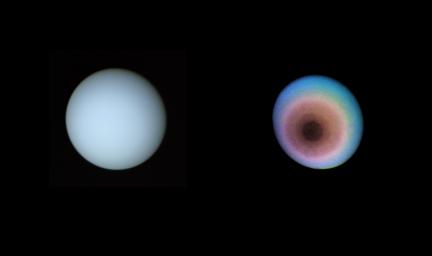- Original Caption Released with Image:
-
These two pictures of Uranus were compiled from images recorded by Voyager 2 on Jan. 10, 1986, when the NASA spacecraft was 18 million kilometers (11 million miles) from the planet. The images were obtained by Voyager's narrow-angle camera; the view is toward the planet's pole of rotation, which lies just left of center. The picture on the left has been processed to show Uranus as human eyes would see it from the vantage point of the spacecraft. The second picture is an exaggerated false-color view that reveals details not visible in the true-color view -- including indications of what could be a polar haze of smog-like particles. The true-color picture was made by combining pictures taken through blue, green and orange filters. The dark shading of the upper right edge of the disk is the terminator, or day-night boundary. The blue-green appearance of Uranus results from methane in the atmosphere; this gas absorbs red wavelengths from the incoming sunlight, leaving the predominant bluish color seen here. The picture on the right uses false color and contrast enhancement to bring out subtle details in the polar region of the atmosphere. Images shuttered through different color filters were added and manipulated by computer, greatly enhancing the low-contrast details in the original images. Ultraviolet, violet- and orange-filtered images were displayed, respectively, as blue, green and red to produce this false-color picture. The planet reveals a dark polar hood surrounded by a series of progressively lighter convective bands. The banded structure is real, though exaggerated here. The brownish color near the center of the planet could be explained as being caused by a thin haze concentrated over the pole -- perhaps the product of chemical reactions powered by ultraviolet light from the Sun. One such reaction produces acetylene from methane -- acetylene has been detected on Uranus by an Earth-orbiting spacecraft -- and further reactions involving acetylene are known to produce reddish-brown smog-like particles. A similar haze envelopes Saturn's moon Titan; ground-based observations have predicted such a haze in the polar regions of Uranus. The exact identification of the reactions and their products will require additional study. Voyager 2 is heading for a Jan. 24 closest approach to Uranus. The Voyager project is managed for NASA by the Jet Propulsion Laboratory.
- Image Credit:
-
NASA/JPL
Image Addition Date: -
1998-12-05
|

 Planetary Data System
Planetary Data System












